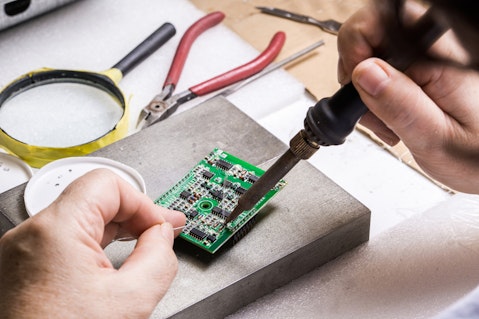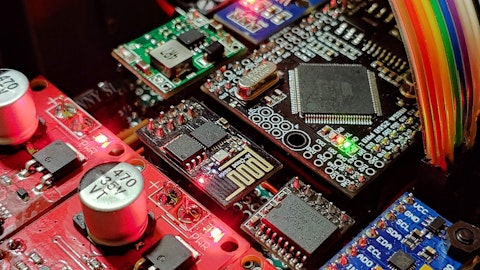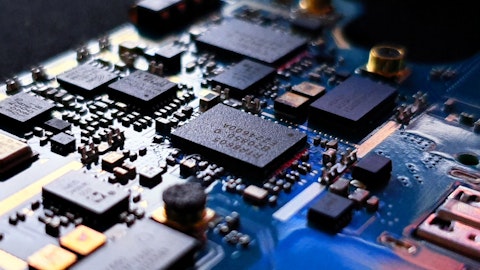Microchip Technology Incorporated (NASDAQ:MCHP) Q1 2024 Earnings Call Transcript August 3, 2023
Operator: Welcome to the First Quarter Fiscal 2024 Conference Call. I will now turn the call over to today’s host Eric Bjornholt, Chief Financial Officer of Microchip. You may begin.
Eric Bjornholt: Good afternoon everybody. During the course of this conference call, we will be making projections and other forward-looking statements regarding future events or the future financial performance of the company. We wish to caution you that such statements are predictions and that actual events or results may differ materially. We refer you to our press releases of today, as well as our recent filings with the SEC that identify important risk factors that may impact Microchip’s business and results of operations. In attendance with me today are Ganesh Moorthy, Microchip’s President and CEO; Steve Sanghi, Microchip’s Executive Chair; and Sajid Daudi, Microchip’s Head of Investor Relations. I will comment on our first quarter fiscal year 2024 financial performance.

Posonskyi Andrey/Shutterstock.com
Ganesh will then provide commentary on our results and discuss the current business environment as well as our guidance, and Steve will provide an update on our cash return strategy. We will then be available to respond specific investor and analyst questions. We are including information in our press release and on this conference call on various GAAP and non-GAAP measures. We have posted a full GAAP to non-GAAP reconciliation on the Investor Relations page of our website at www.microchip.com and included reconciliation information in our earnings press release, which we believe you will find useful when comparing our GAAP and non-GAAP results. We have also posted a summary of our outstanding debt and our leverage metrics on our website. I will now go through some of our operating results including net sales, gross margin and operating expenses.
Other than net sales, I will be referring to these results on a non-GAAP basis, which is based on expenses prior to the effects of our acquisition activities, share based compensation and certain other adjustments that are described in our earnings press release and in the reconciliation on our website. Net sales in the June quarter were $2.289 billion, which was up to 2.5% sequentially. We have posted a summary of our net sales by product line and geography on our website for your reference. On a non-GAAP basis, gross margins were a record at 68.4%, operating expenses were at 20.3% and operating income was a record 48.1%. Non-GAAP net income was $905.3 million and Non-GAAP earnings per share on a diluted basis was a record $1.64. On a GAAP basis in the June quarter gross margins were a record at 68.1%.
Total operating expenses were $655.3 million and included acquisition and tangible amortization of a $151.5 million, special charges of $1.7 million, share bases compensation of $37.7 million and a benefit of $0.4 million for other matters. GAAP net income was a record $666.4 million, resulting in a record $1.21 in per diluted share. Our non-GAAP cash tax rate was 14.2% in the June quarter. Our non-GAAP tax rate for fiscal year 2024 is expected to be about 14%, which is exclusive of the transition tax and any tax audit settlements related to taxes accrued in prior fiscal years. Our fiscal ‘24 cash tax rate is expected to be higher than our fiscal ‘23 tax rate for a variety of factors, including lower availability of tax attributes, such as net operating losses, tax credits, lower tax depreciation and our expectation for lower capital expenditures in the U.S. in fiscal ’24, as well as the impact of current tax rules requiring the capitalization of R&D expenses for tax purposes.
We are still hopeful that the tax rules requiring companies to capitalize R&D expenses will be pushed out or repealed. If that were to happen, we would anticipate about a 200 basis point favorable adjustment to Microchips, non-GAAP tax rate in future periods. Our inventory balance at June 30, 2023 was $1.336 billion. We had 167 days of inventory at the end of the June quarter, which was down two days from the prior quarter’s level. Although we reduced inventory days in the quarter, we were not able to make as much progress as we would have liked to, as we accommodated requests by customers to push out delivery schedules for products that were very far through the manufacturing process. We also continue to invest in building inventory for products with long lives and high margins, whose manufacturing capacity is being end of life by our supply chain partners, and these last-time buys represented eight days of inventory at the end of June.
We expect dollars and days of inventory on our balance sheet to reduce in the September quarter. Inventory at our distributors in the March quarter – excuse me, in the June quarter was at 29 days, which was up five days from the prior quarter’s level. Compared to our other regions, inventory at our Asia distributors grew the most in the quarter, as sell-through activity was down significantly on a sequential basis in this region, heavily driven by unfavorable business conditions in China. Our cash flow from operating activities was $993.2 million in the June quarter. Included in our cash flow from operating activities was $106.1 million of long-term supply assurance receipts from customers. We have adjusted these items out of our free cash flow to determine the adjusted free cash flow that we will return to shareholders through dividends and share repurchases, as these supply assurance payments will be refundable over time, as purchase commitments are fulfilled.
Our adjusted free cash flow was $776 million in the June quarter. As of June 30, our consolidated cash and total investment position was $271.2 million. We paid down $413 million of total debt in the June quarter, and our net debt was reduced by $450.2 million. Over the last 24 quarters, since we closed the Microsemi acquisition, and incurred over $8 billion in debt to do so, we have paid down $6.76 billion of debt and continue to allocate substantially all of our excess cash beyond dividends and stock buyback to bring down this debt. In the June quarter, we retired $1 billion in bonds that matured using our line of credit to do so. Our line of credit had $725 million of borrowings against it at June 30, 2023, after paying off the $1 billion in bonds.
During the June quarter we also retired $38 million of total principal amounts of our 2025, 2027 and 2037 convertible bonds for a total cash payment of $90.1 million. The amount paid above the principal amount essentially works like a synthetic stock buyback, reducing any current and future share count dilution that will result if these convertible bonds were ever converted into shares. The over $50 million we paid above the par value for the convertible bonds was in addition to our normal share buyback activity that we executed during the quarter, resulting in an additional reduction in the dilutive shares outstanding. Our adjusted EBITDA in the June quarter was a record at $1.172 billion and 51.2% of net sales. Our trailing 12-month adjusted EBITDA was also a record at $4.473 billion.
Our net debt to adjusted EBITDA was $1.29 at June 30, 2023, down from $1.45 at March 31, 2023, and down from $2.05 at June 30, 2022. Capital expenditures were $111.1 million in the June quarter. Our expectation for capital expenditures for fiscal year 2024 is between $300 million and $400 million, as we still have a lot of equipment that was ordered with long lead times that we will be receiving over the next year. We expect that our capital investments will continue to provide us with increased control over our production during periods of industry-wide constraints. Depreciation expense in the June quarter was $50.5 million. I will now turn it over to Ganesh, to give his comments on the performance of the business in the June quarter, as well as our guidance for the September quarter.
Ganesh?
Ganesh Moorthy: Thank you, Eric, and good afternoon everyone. Our June quarter results were strong in the context of a slowing macro environment, marked by our continued disciplined execution, as well as our resilient end markets and diversified customer base. Net sales grew 2.5% sequentially and 16.6% on a year-over-year basis to achieve another all-time record of $2.29 billion. The June quarter represented our 11th consecutive quarter of sequential revenue growth. Non-GAAP gross and operating margins were both records at 68.4% and 48.1% respectively. Our consolidated non-GAAP diluted earnings per share was $1.64 per share, another record by a whisker and up 19.7% from the year-ago quarter. Adjusted EBITDA was a record 51.2% of net sales and adjusted free cash flow was 33.9% of net sales in the June quarter, continuing to demonstrate the robust cash generation characteristics of our business.
Our net leverage exiting June dropped to 1.29x. We returned $349.2 million to shareholders in dividends and share repurchases in the June quarter, representing 67.5% of our March quarter adjusted free cash flow. Our capital return to shareholders in the September quarter will increase to 72.5% of our June quarter adjusted free cash flow, as we continue on our path to return 100% of our adjusted free cash flow to shareholders by the March quarter of calendar year 2025. My profuse thanks to all our stakeholders who enabled us to achieve these outstanding results despite the increasingly challenging macro environment, and especially to the worldwide Microchip team whose tireless efforts and agility to adapt are what enable us to navigate effectively through the business cycles.
Taking a look at our June quarter net sales from a product line perspective, our mixed signal microcontroller net sales set another all-time record, coming in sequentially up 0.8% in the June quarter and up 22.5% on a year-over-year basis. Our analog net sales also set another all-time record, coming in sequentially up 2.5% in the June quarter and up 9.2% on a year-over-year basis. Our FPGA net sales, which we comment on from time-to-time, had another record quarter with annualized revenue growth continuing to be in the double digits. Now for some color on the June quarter. While our overall business remains steady, our customers continue to feel the effects of slowing economic activity and increasing business uncertainty. Starting in early June, we saw business conditions deteriorate in three areas.
First, our China business was much weaker than our expectations and has not recovered from the shutdowns of last year and the Lunar New Year holidays in the March quarter. This manifested in weak sell-through activity and the building of inventory in the distribution channel in China. Second, we started to see initial signs of weakness and uncertainty in the automotive and industrial segments, reflecting the impact of high inflation and high interest rates driving more cautious spending. And third, we are seeing early signs of an impending slowdown in Europe, exacerbated by some of our European customers being dependent on exports to countries like China, whereas we know that the business environment is much weaker than expected. As a result, we continue to receive requests to push out or cancel backlog as customers start to rebalance their inventory in light of the weaker business conditions and increased uncertainty they were experiencing.
We were able to push out meaningful amounts of non-reschedulable backlog to later quarters to help many customers with inventory positions. While the rate of cancellation and push-out requests appears to be stabilizing, we expect request to push out or cancel backlog will likely be with us through the rest of calendar 2023, as customers adjust to their new demand environment and attempt to de-risk their inventory position commensurately. We are also seeing an increasing direct and indirect impact from the cumulative effect of U.S. export control actions, especially in China. These actions were less of an issue over the last few quarters when demand was significantly higher than supply, but are more of an issue now as demand and supply come more into balance.
Despite all the factors mentioned so far, in the June quarter we were able to reverse the growth in days of inventory on our balance sheet, with inventory dropping by two days to 167 days, of which, eight days of inventory were from an investment in last-time buys of high-margin, long-lived products whose manufacturing capacity was being end of life by our supply chain. Reflecting the slowing macro-environment, especially in China, our channel inventory grew by 5 days to 29 days. We continue to take actions to further reduce the days of inventory on our balance sheet, while maintaining absorption in our internal wafer fabrication factories. We’re also working with our channel partners to find the right balance of inventory required to serve customers and to be positioned for an eventual strengthening of business conditions.
Finally, while our overall inventory is still a bit higher than our target, we made excellent progress to position our inventory at the best locations in manufacturing to be able to rapidly respond to demand growth when the macro environment strengthens. Consistent with the slowing macro environment and the higher than target level of inventory on our balance sheet, as well as with some of our customers and channel partners, most of our internal factory expansion actions remain paused. This we expect will result in lower capital investments in fiscal year ‘24 and fiscal year ‘25. During a period of macro weakness and business uncertainty, we believe shorter lead times are the best way to help customers navigate the environment successfully, and improve the quality of backlog placed on us.
We have been able to reduce average lead time from roughly 52 weeks at the start of 2023 to roughly 26 weeks by the end of the June quarter, and we expect to continue to drive lead times down farther in the coming months. We have heard concerns from some of the investment community about falling lead times, because it results in lower backlog. While this is often true, we believe the level of backlog does not equate to true end market consumption. And in the final analysis, shorter lead times enable our customers and Microchip to navigate an uncertain environment with agility and more effectively. So now let’s get into the guidance for the September quarter. Although our backlog for the September quarter is strong, we are continuing to take active steps to help customers with inventory positions to push out their backlog.
Taking all the factors we have discussed on the call today into consideration, we expect our net sales for the September quarter to be between up 1% and down 3% sequentially. At the midpoint of our net sales guidance for the September quarter, our year-over-year growth for the quarter would be 9.3%. We expect our non-GAAP gross margin to be between 68.3% and 68.5% of sales. We expect non-GAAP operating expenses to be between 20.1% and 20.5% of sales. We expect non-GAAP operating profit to be between 47.8% and 48.4% of sales and we expect our non-GAAP diluted earnings per share to be between $1.60 and $1.64. At the midpoint of our non-GAAP earnings per share guidance, our year-over-year growth for the September quarter would be 11% despite a much higher tax rate than the year-ago quarter.
As supply and demand come into balance, we expect normal seasonality to return to our business. Historically, the December quarter has been our seasonally weakest quarter. This year, we expect that our normal seasonality in the December quarter will likely be amplified by the macro weakness and business uncertainty that our customers are experiencing. As a result, we anticipate further business headwinds in the December quarter. However, notwithstanding any near-term macro weakness, we are confident that semiconductors remain the engine of innovation for the markets and applications we serve. Our focus on total system solutions and key market megatrends continues to fuel strong design momentum, which we expect will drive above-market long-term growth.
Finally, as you can see from our June quarter results and our September quarter guidance, our Microchip 3.0 strategy which we launched 21 months ago, continues to be the foundation of our results, as we continue to build and improve what we believe is one of the most diversified, defensible, high-growth, high-margin, high-cash generating businesses in the semiconductor industry. However, we recognize that we operate in a cyclical industry and that we’re not immune to the business cycles. If you review Microchip’s peak to trough performance through the business cycles over the last 15-plus years, which is included in the investor presentation posted on our website, you will observe our robust and consistent cash-generation, gross margin and operating margin results.
Although we don’t know what exactly the future holds, if we were to experience a semiconductor inventory correction like what the industry has seen in the past, we are highly confident that our non-GAAP operating margins would remain well above 40%, and we expect our cash-generation, non-GAAP gross margin, and non-GAAP operating margin to once again demonstrate consistency and resiliency through the cycle. And with that, let me pass the baton to Steve to talk more about our cash return to shareholders. Steve.
Steve Sanghi: Thank you, Ganesh, and good afternoon everyone. I would like to reflect on our financial results announced today and provide you further updates on our cash return strategy. Reflective on our financial results, I continue to be very proud of all employees of Microchip that have delivered another exceptional quarter while making new records in many respects, namely record net sales, record non-GAAP gross margin percentage, record non-GAAP operating margin percentage, record non-GAAP EPS and record adjusted EBITDA, and all of that in a continuing challenging environment. The Board of Directors announced an increase in the dividend of 36.2% from the year ago quarter to $0.41 per share. During the last quarter we purchased $140.3 million of our stock in the open market.
We also paid out $208.9 million in dividends, thus the total cash return was $349.2 million. This amount was 67.5% of our actual adjusted free cash flow of $517.3 million during the March 2023 quarter. Our pay down of debt, as well as record adjusted EBITDA, drove down a net leverage at the end of June 2023 quarter to 1.29x from 2.05x at the end of June 2022. Ever since we achieved an investment great rating for our debt in November 2021 and pivoted to increasing our capital return to shareholders, we have returned $2.686 billion to shareholders through June 30, 2023 by a combination of dividends and stock buybacks. In the current September quarter we will use the adjusted free cash flow from the June quarter to target the cash returned to shareholders.
The adjusted free cash flow excludes a net $106.1 million that we collected from our customers for long-term supply assurance payments. These payments are refundable when purchase commitments are fulfilled. The adjusted free cash flow for the June quarter was $776 million. We plan to return 72.5% or $562.6 million of that amount to our shareholders with the dividend expected to be approximately $223 million and the stock buyback expected to be approximately $339.6 million. Going forward, we plan to continue to increase free cash flow return to shareholders by 500 basis points every quarter until we reach 100% of our adjusted free cash flow return to shareholders. This will take six more quarters, and dividends over time we expect will represent approximately 50% of our cash returned.
With that operator will you please poll for questions?
See also 20 Most Educated States in America and 10 Oversold Financial Stocks to Buy.
Q&A Session
Follow Microchip Technology Inc (NASDAQ:MCHP)
Follow Microchip Technology Inc (NASDAQ:MCHP)
Operator: [Operator Instructions]. Our first question is going to come from Tore Svanberg with Stifel. Your line is open.
Tore Svanberg: Yes, thank you. I was hoping you could talk a little bit more about your orders. I mean up backlog and the backlog that will make sense, but I was just wondering if you could update us on orders especially by region, and are you seeing any sort of signs of life at all from China, because obviously they are trying to stimulate the economy and just wondering if you’ve seen any data points there at all.
Ganesh Moorthy: I think going through the month of July, we have not yet seen China recover. There are discussions I understand about things they may do in the rest of this quarter, those have to be seen. So I don’t have anything more to add with respect to China. Our bookings have been weak. We do expect in time that those will begin to strengthen. There is still a lot of backlog that we are carrying and we are pushing out backlog. So there is not an immediate requirement for bookings to spring back to where they used to be.
Tore Svanberg: Perfect. Thank you.
Ganesh Moorthy: You’re welcome.
Eric Bjornholt: Maybe I can just add to that. You know bookings are a reflection of where lead times are and with lead times coming down, the customers just aren’t viewing that they need to put the backlog in place, because our lead times are falling pretty rapidly.
Tore Svanberg: Make sense. Thank you, Eric.
Operator: Our next question is going to come from Vijay Rakesh with Mizuho. Your line is open.
Vijay Rakesh : Yes, hi. Just a quick question. I was wondering, when you look at your supply chain, where are you seeing any – what are you seeing on the pricing side if you were to look at China or just globally?
Ganesh Moorthy: You know, supply chains are stable in most places where we buy wafers from, where we buy some of our assembly and test services from. Clearly, on some of the materials, there may have been some movement in certain cases. I don’t think we track it at the level that perhaps you may be interested in. But I would say supply chains are stable, lead times have come down, we’re able to get what we need.
Vijay Rakesh : Got it. And in general, if you look at trends as you look out on the pricing side, any thoughts you could share? I mean, what has been trends and what have you seen in the last two, three years and how you see that going forward, I guess. That’s it, thanks a lot.
Ganesh Moorthy: In our business, for the embedded solutions business, pricing tends to be a lot more stable. Pricing is something you establish at the point of doing your new design and activity, not at the point at which you’re fulfilling demand that’s coming in. And outside of the last two years where there was significant inflation that we faced and that we passed on to our customers, pricing is usually relatively stable over time. We’re not looking to reduce pricing or to increase pricing. And as we go forward, I don’t expect that it’s going to change in the way that our business runs.
Vijay Rakesh : All right, thank you.
Eric Bjornholt: You’re welcome.
Operator: Our next question is going to come from Vivek Arya with Bank of America Securities. You’re in line as open.
Vivek Arya : Thanks for taking my question. Sort of a multi-part, but related Ganesh. When I look at the September quarter outlook, it’s kind of flattish, even though you’re describing the situation at getting somewhat tougher. And then as I look out to the December quarter, I think you mentioned it could be worse than seasonal. But even with the headwinds, do you see a scenario where Microchip could continue to grow year-on-year or you think we should be thinking about, the first quarter of year-on-year declines. And if they were to, right, decline year-on-year, what would be the effect on gross margins?
Ganesh Moorthy: We haven’t modeled what the December quarter nor are we guiding to what the December quarter is going to be. There are a range of scenarios that we are working with, and I don’t really have any more color to offer on it. With respect to the gross margins, as we have said many times, we have a pretty strong resilience to the way the gross margin works. If you look at our inside-outside mix, we still have a 60% outside mix. We are continuing to run our fact, where for absorption purposes we are building the product that we need to build and building some inventory. So really, I’m not trying to provide any guidance for December that you might have, but you’re absolutely right. We are expecting that the December quarter is going to be weaker than normal seasonality.




